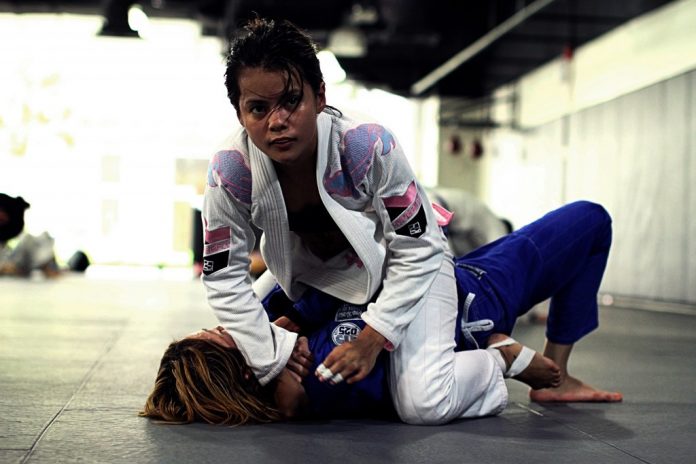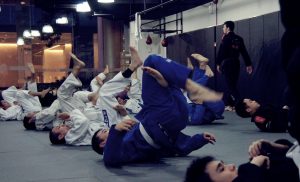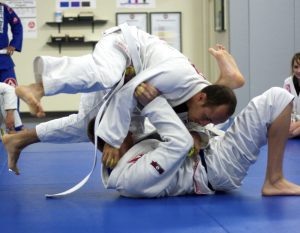
Remember that first year of Jiu-Jitsu? It was hard, wasn’t it? Of course, it was you got smashed, destroyed and utterly humbled. As it should be. We all went through the same process, no exceptions. What makes the whole first year of JIu-Jitsu ordeal easier for a white belt is a good guide. Those that had one probably got through the first 12 months way easier than those flying blind.
Although the blue belt is the hallmark of people quitting the Gentle Art, white belt isn’t far behind. Having a roadmap of reasonable expectations can really make a difference. Yes, the instructors are there to guide new students through it. But wouldn’t it be great to be completely prepared for the struggles of a BJJ newbie from the start? I know I would’ve appreciated a guide outlining what I should expect. hence, I present to you the ultimate guide for getting through the first year of Brazilian Jiu-Jitsu:
Basic BJJ Class structure
BJJ classes are structured in a very precise manner, and there’s the reason behind it all. regardless of level, all classes follow the same structure. It consists of four main parts, that can vary slightly from school to school.
All Jiu-Jitsu classes begin with a warm-up. Now, this is by far the most despised part of a BJJ class, but that doesn’t make it less important than technique training, for example. Warm-ups in BJJ differ greatly, but they’re all aimed towards specific preparation for grappling training. Or, at least, they should be.
The second part of a Jiu-Jitsu class is the technical part. This is where the majority of class time is spent. The instructor/s usually demonstrate/s a technique with a thorough explanation before students get to practice it. The practice is done in pairs where people trade places to give the moves a try. Instructors are available to answer questions during this part of a class.
After going through the technique/s of the day, the same techniques are then practiced, this time in a more realistic scenario. Drilling or position sparring are the methods of choice here. The point is to attempt to practice the practiced move against a moderately resisting opponent.
Finally, the pièce de résistance, live sparring or rolling, as it is known in BJJ. This becomes the most favorite part of new students very fast and remains so through their BJJ journey. However, people in their first year of Jiu-Jitsu need to know how to survive this part of training without injuries or ego-bruising in order to progress. This is where our guide comes in very handy.
Getting The Most Out Of The Warm-up
The first and most important point of a warm-up is to get the body prepared for physical activities. The more specific the activity, the more specific a warm-up should be. Seeing how JIu-Jitsu is a highly specific physical activity, warm-ups are geared towards loosening the body up for doing just that. First and foremost, new students should pay close attention to warm-ups in order to learn the basic movement patterns of the art. Secondly, warm-ups are going to prevent injuries that might keep someone out of the gym and eventually the sport. Finally, it will get you into shape for grappling. Thumbling, bridging, and crawling require a certain degree of coordination and conditioning.
From a conditioning standpoint, be prepared for soreness. Warm-ups might not end up being that difficult for you, but an entire class will. No matter how much you bench or how many marathons you’ve run, you’ll gas out. The first few months of BJJ are marked with DOMS (Delayed Onset Muscle Soreness) that can keep you off the mats. Warm-ups make sure your body is ready for training even while waking up sore all over. Once you warm up properly you’ll be ready for every part of a class, regardless of soreness level.
Technical Tips For Your First Year Of Jiu-Jitsu
First and foremost be ready to be completely overwhelmed by the techniques. And, by overwhelming, I mean in every possible way. From a sheer number of techniques to variations, you see from higher belts to the names of moves that make no sense. however, there is hope, Do not worry, there’s a system to the madness. Actually, there are two.
To begin with, new students are enrolled in the fundamentals program. It is a curriculum that introduces students to BJJ and the most common positions and moves associated with it. Secondly, you have our guide, that goes beyond the fundamental curriculum offering you even more insight into what you’re doing.
Let’s look at the nomenclature. During your first year of Jiu-Jitsu, you will hear a lot of things that make no sense. From normal stuff like “side control” to obscure terms like “reverse De La Spider Guard”, you’ll hear it all. In order to remember what every term means, make sure you remember one thing first – repetition is key. As long as you show up to class, you’ll hear, see and do the same stuff over and over again. It’s the best way to learn. Also, stick to the Fundamentals. They teach you a select number of crucial techniques that are important to remember.
One great way of ensuring technical progress in your training is taking notes. That doesn’t mean you should get a notebook and write during a demonstration of techniques. After class, or even better, at home should do the trick. Built system of your own, that will allow you to remember and connect all that you’ve learned.
On a final note, just make sure you return to class, Do not skip classes and your technical progress is going to be fast and continuous.
Rolling Survival Guidelines
“Check your ego at the door” You’ll find this sentiment associated with BJJ very often. In case you do not know how to do it, don’t worry. Your ego is going to get checked at the door regardless. You just need to know how to cope with it. Getting beat in rolling is no big deal. Actually, it doesn’t mean anything at all. Embrace the grind and learn from every little thing you do wrong. During your first year of Jiu-Jitsu, almost everything will go wrong. It’s ok. It’s even expected of you. Everyone went through the same process before they got a different colored belt. Stay humble and you’ll soon be humbling others.
One major component of rolling is the close proximity of people. In BJJ, there’s an inherent battel fro space in almost every position. This means that people are going to insist on being up close and personal to you. For the untrained beginner, this can often lead to feelings of claustrophobia and even panic. If this is the case with you there’s only one thing you need to remember in order to overcome it. Breathe! Focus on finding the tiniest of spaces and getting air through it. Forget about muscling your way out of a position, just breathe and it’ll relax you. From there. it’s way easier to see a way out.
Finally, from a more technical perspective, please do not go and attempt YouTube techniques in rolling during your maiden year. You’ll just suffer because of it. The only certain way to succeed is through the fundamentals. Stick to what you’re shown in the technical part of a class and you’ll do just fine. And. once again, tap often and tap early. That’s the only way forward in BJJ.
Shortcuts and Directions For The Fastest Progress in Jiu Jitsu
9 Jiu-Jitsu Things Non-Grappling Folks Need To Understand About Us


![Darce Choke Encyclopedia – Origins, Mechanics and Variations [2024] BJJ, choke, Brabo, BJJ Darce Choke, D'arce Choke, Darce BJJ Choke](https://bjj-world.com/wp-content/uploads/2017/11/JungPoirierLeeYahoo-218x150.jpg)












![Leg Lock Stock And Barrel Taylor Pearman DVD Review [2025] Leg Lock Stock And Barrel Taylor Pearman DVD Review](https://bjj-world.com/wp-content/uploads/2025/03/leg-lock-stock-and-barrel-taylor-pearman-dvd-review-218x150.png)

![I Got Your Back Jake Straus DVD Review [2025] I Got Your Back Jake Straus DVD Review](https://bjj-world.com/wp-content/uploads/2025/03/i-got-your-back-jake-straus-dvd-review-218x150.png)
![Shotgun Aoki Locks Mateusz Szczecinski DVD Review [2025] Shotgun Aoki Locks Mateusz Szczecinski DVD Review](https://bjj-world.com/wp-content/uploads/2025/03/shotgun-aoki-locks-mateusz-szczecinski-dvd-review-218x150.png)



![The Rack Kyle Watson BJJ DVD Review [2025] The Rack Kyle Watson BJJ DVD Review](https://bjj-world.com/wp-content/uploads/2024/12/the-rack-kyle-watson-bjj-dvd-review-100x70.png)
![Heavy Top Game Fabiano Scherner BJJ DVD Review [2025] Heavy Top Game Fabiano Scherner BJJ DVD Review](https://bjj-world.com/wp-content/uploads/2025/01/heavy-top-game-fabiano-scherner-bjj-dvd-review-100x70.png)
![Nicholas Meregali No-Gi System DVD Unpacked: A Detailed Review [2024] Nicholas Meregali No-Gi System DVD Unpacked: A Detailed Review](https://bjj-world.com/wp-content/uploads/2024/09/nicholas-meregali-no-gi-system-dvd-unpacked-review-100x70.png)
![Kill The Underhook Dima Murovanni DVD Review [2024] Kill The Underhook Dima Murovanni DVD Review](https://bjj-world.com/wp-content/uploads/2024/10/kill-the-underhook-dima-murovanni-dvd-review-100x70.png)

![Woj Lock the World Chris Wojcik Ankle Locks DVD Review [2024] Woj Lock the World Chris Wojcik Ankle Locks DVD Review](https://bjj-world.com/wp-content/uploads/2024/12/woj-lock-the-world-chris-wojcik-dvd-review-100x70.png)
![Modern Split Squat Passing Jason Rau DVD Review [2024] Modern Split Squat Passing Jason Rau DVD Review](https://bjj-world.com/wp-content/uploads/2024/11/modern-split-squat-passing-jason-rau-dvd-review-100x70.png)
![Charles Allan Price Building Workouts For BJJ DVD Review [2024] Charles Allan Price Building Workouts For BJJ DVD Review](https://bjj-world.com/wp-content/uploads/2024/09/charles-allan-price-building-workouts-for-bjj-review-100x70.png)
![EMU Guard 2.0 Benjamin Power DVD Review [2024] EMU Guard 2.0 Benjamin Power DVD Review](https://bjj-world.com/wp-content/uploads/2024/11/emu-guard-2-0-benjamin-power-dvd-review-100x70.png)


![Slay The Wrestle Up Guard Nick Rodriguez DVD Review [2024] Slay The Wrestle Up Guard Nick Rodriguez DVD Review](https://bjj-world.com/wp-content/uploads/2024/12/slay-the-wrestle-up-guard-nick-rodriguez-dvd-review-100x70.png)
![Back Control and Submission Felipe Pena DVD Reveiw [2025] Back Control and Submission Felipe Pena DVD Reveiw](https://bjj-world.com/wp-content/uploads/2025/01/back-control-and-submission-felipe-pena-dvd-reveiw-100x70.png)
![Position And Submission Escapes Craig Funk DVD Review [2025] Position And Submission Escapes Craig Funk DVD Review](https://bjj-world.com/wp-content/uploads/2025/02/position-and-submission-escapes-craig-funk-dvd-review-100x70.png)
![A Blueprint For Smeshing Khabib Nurmagomedov DVD Review [2024] A Blueprint For Smeshing Khabib Nurmagomedov DVD Review](https://bjj-world.com/wp-content/uploads/2024/10/blueprint-for-smeshing-khabib-nurmagomedov-dvd-review-100x70.png)



![Master The Move The American Lock John Danaher DVD Review [2024] Master The Move The American Lock John Danaher DVD Review](https://bjj-world.com/wp-content/uploads/2024/12/the-american-lock-john-danaher-dvd-review-100x70.png)
![Creating Back Exposure Luke Griffith DVD Review [2025] Creating Back Exposure Luke Griffith DVD Review](https://bjj-world.com/wp-content/uploads/2025/01/creating-back-exposure-luke-griffith-dvd-review-100x70.png)

![Jeff Higgs Self Defense Guard BJJ DVD Review [2024] Jeff Higgs Self Defense Guard BJJ DVD Review](https://bjj-world.com/wp-content/uploads/2024/09/jeff-higgs-self-defense-guard-bjj-dvd-review-100x70.png)



![Double Sleeve Guard Jon Thomas BJJ DVD Review [2024] Double Sleeve Guard Jon Thomas BJJ DVD Review](https://bjj-world.com/wp-content/uploads/2024/10/double-sleeve-guard-jon-thomas-bjj-dvd-review-100x70.png)